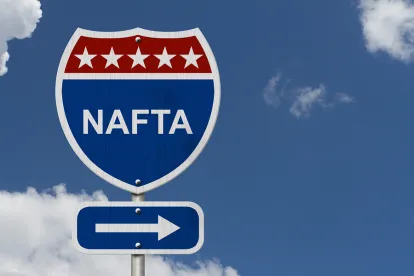The first round of the renegotiation of the North American Free Trade Agreement (“NAFTA”) with Canada and Mexico has official drawn to a close, and the second round is scheduled for Mexico City in early September. U.S. companies doing business in Canada and Mexico are urged to monitor and stay abreast of new developments, and assess how proposed changes to the NAFTA could impact their products, operations and supply chains. The following provides a timeline of the NAFTA renegotiation process, and where we may be headed from here.
-
May 18, 2017: The U.S. Trade Representative (“USTR”) submitted formal notification to Congress of the Trump Administration’s intent to commence negotiations with Canada and Mexico to modernize the NAFTA, noting that renegotiation was warranted because many provisions of the agreement are outdated and do not reflect modern standards in areas such as digital trade, intellectual property rights, and regulatory practices, among others.
-
May and June 2017: The USTR requested public comments with regard to the modernization of the NAFTA on May 23, 2017, and held a public hearing from June 27th – 29th at the International Trade Commission. More than 12,000 written responses were submitted to the USTR, and more than 140 witnesses testified during the hearing, representing various industry sectors. The majority of the opinions presented reflected U.S. industries’ support of the NAFTA because of the significant increase in U.S. exports to Mexico and Canada since the agreement entered into force in 1994. Industry also urged that the negotiations should not jeopardize existing market access gains by U.S. companies, and that the key negotiating principle should be, “Do No Harm” as suggested previously by USTR Lighthizer.
-
July 17, 2017: The USTR published a summary of its specific objectives for the renegotiation of the NAFTA, as outlined in greater detail below. The USTR acknowledged that the agreement contributed to the linking of the continent through trade and provided new market access opportunities for American farmers and ranchers, while commenting that the NAFTA created problems for many American workers as a result of the increase in trade deficits and the closing of U.S. factories.
-
August 16 – 20, 2017: As noted above, the first round of talks took place between August 16 – 20 in Washington, D.C. Presentations were made by the United States, Mexico and Canada on the scope of the NAFTA, the three countries agreed on the need to update the NAFTA rules, and negotiating groups began work on drafting new provisions, comments and proposals. Negotiators from each country will continue domestic consultations with the private sector, industry associations, labor groups, legislative representatives and state officials, and will advance negotiating text through the end of August. The renegotiation of the NAFTA will entail seven rounds which will be held in three-week intervals in order to ensure that the process is concluded before Mexico’s 2018 presidential election is in full swing.
-
September & October 2017: The second round of talks is scheduled to reconvene in Mexico City from September 1st to the 5th. The third round will take place in Canada in late September, with a fourth round slated for late October back in the United States.
Upon the conclusion of all seven rounds, if consensus is reached, the agreement will ultimately be submitted to Congress for approval. Because the President currently has what is known as “Trade Promotion Authority,” Congress must consider the renegotiated agreement, work with the Administration on drafting the implementing legislation, and vote without making any additional amendments to the agreement itself.
The issues that are likely to pose the most obstacles for the negotiators include raising the NAFTA country of origin content requirements for the automotive sector, and the U.S.’s proposal to eliminate the NAFTA’s Chapter 19 dispute settlement mechanism for resolving complaints about illegal subsidies and dumping.
U.S. companies that have operations in, source from, or market to customers in Canada and Mexico should continue to stay updated on the renegotiation of the NAFTA, reach out to members of Congress and other key government decision-makers, assess how proposed changes to the NAFTA may impact their products and supply chains, and ensure that their companies’ interests are considered and protected throughout this process.



 />i
/>i

